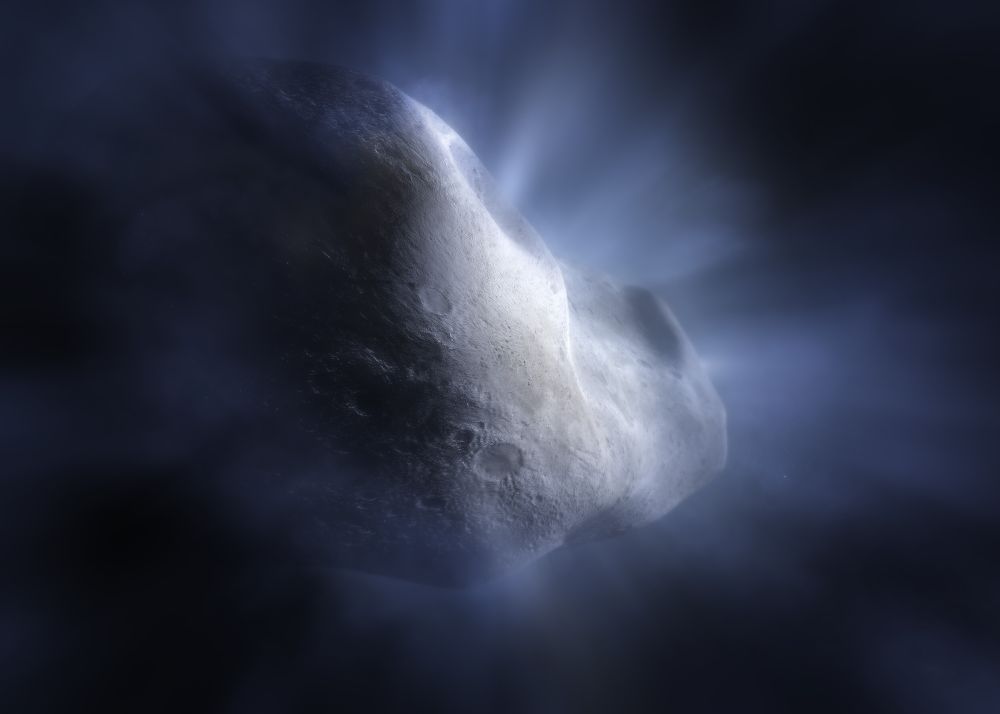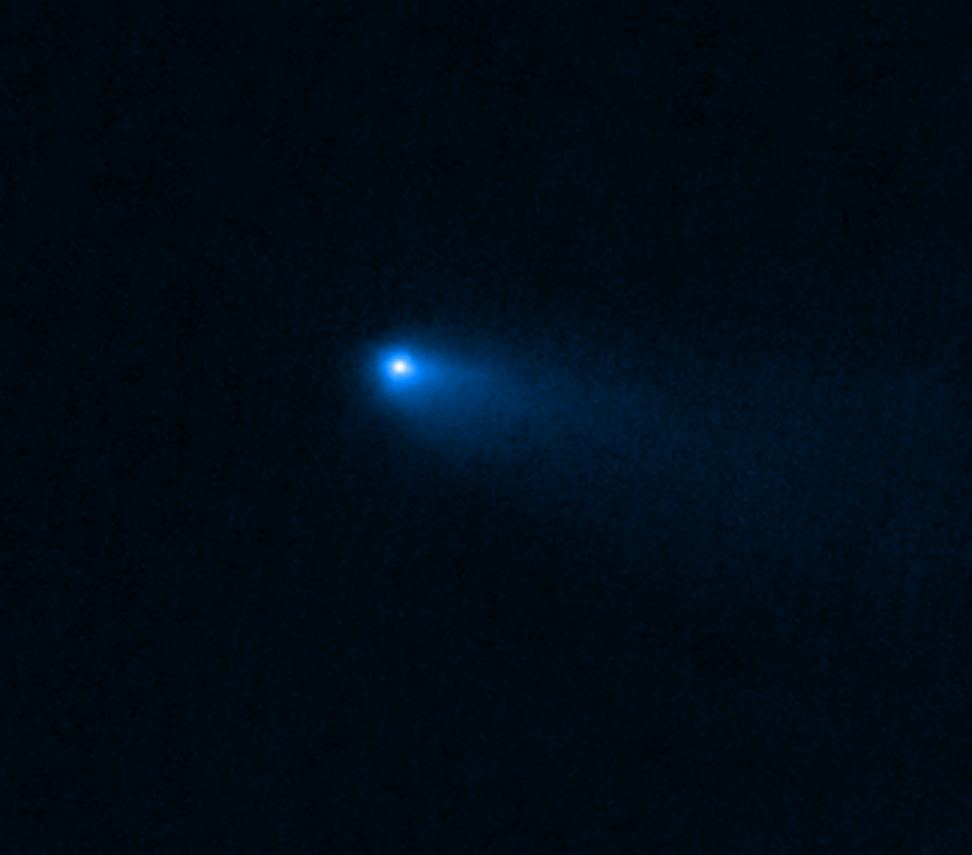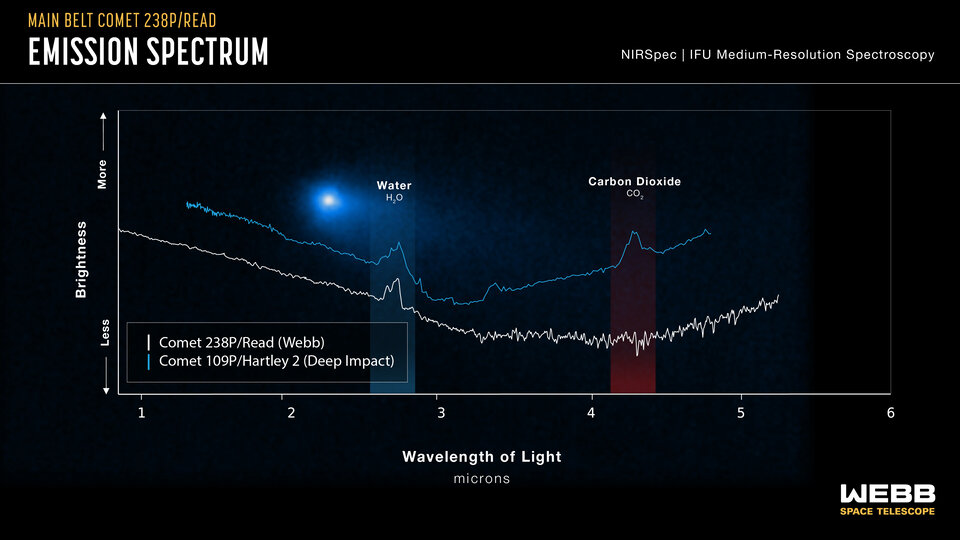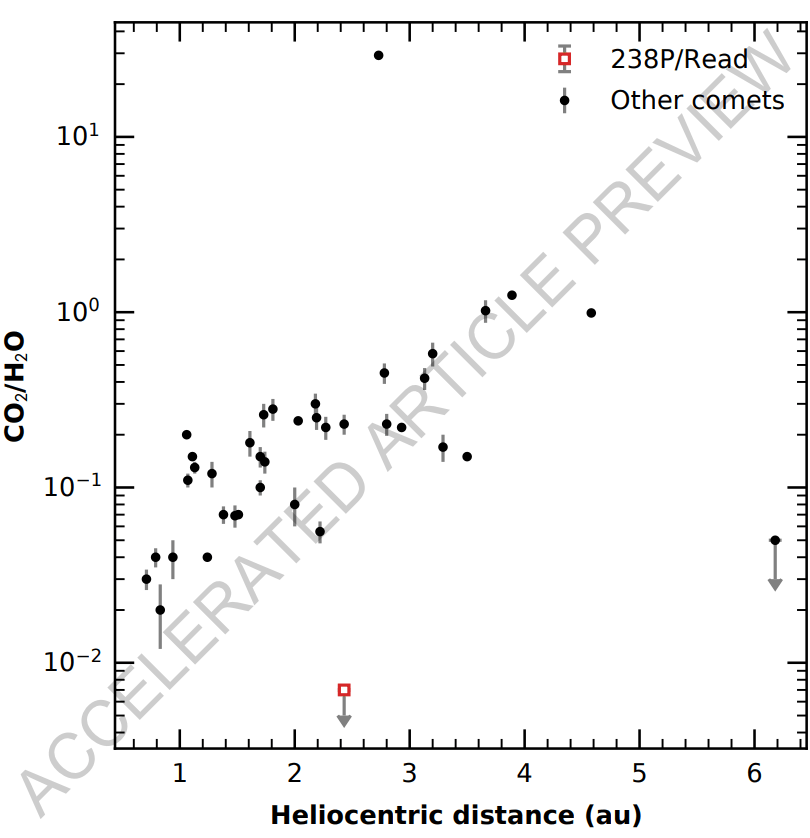Comets are instantly recognizable by their tails of gas and dust. Most comets originate in the far, frozen reaches of our Solar System, and only visit the inner Solar System occasionally. But some are in the Main Asteroid Belt, mixed in with the debris left over after the Solar System formed.
Astronomers just found water vapour coming from one of them.
“With Webb’s observations of Comet Read, we can now demonstrate that water ice from the early Solar System can be preserved in the asteroid belt.”
Michael Kelley, University of Maryland
Our Solar System’s collection of asteroids is contained mostly in a belt between the orbits of Jupiter and Mars. Though we call this torus of debris the Main Asteroid Belt, it might be more properly called a circumstellar disk: debris left over after planets have formed in a solar system.

Active asteroids are asteroids that suffer mass loss through some mechanism or another. But some of these active asteroids display activity that’s more appropriate for a comet than an asteroid. They have tails and comae that make them instantly recognizable as comets, though they follow orbits like any other asteroid. Since they’re in the Main Belt, astronomers call them Main Belt Comets (MBCs.) Astronomers pointed the James Webb Space Telescope (JWST) at one of them and detected water vapour, the first time it’s been detected in one of these objects.
A team of researchers presented this discovery in a new paper in Nature titled “Spectroscopic identification of water emission from a main-belt comet.” The lead author is Michael Kelley, a principal research scientist in the University of Maryland’s Department of Astronomy.
Comets shed this material when they approach the Sun, and its heat sublimates their volatile ices from solids to gases. The tails and comae are made of vapour and dust that’s carried off the surface with the vapour. Astronomers have been looking for water vapour in an MBC for years without finding it. The discovery both answers a question and asks one, while at the same time adding to the complexity behind the origins of Earth’s life-giving water.
“Our water-soaked world, teeming with life and unique in the Universe as far as we know, is something of a mystery – we’re not sure how all this water got here.”
Stefanie Milam, Webb Deputy Project Scientist for Planetary Science, paper co-author.
The MBC is called Comet 238P/Read, and it’s about 600 meters (2,000 ft.) in diameter. Astronomer Michael Read discovered it in 2005, and it’s one of the first objects to be classified as a main-belt comet.

The JWST’s NIRCam instrument captured this image of Comet 238P/Read in September 2022. Image Credit: By NASA, ESA, CSA, and STScI, CC BY 4.0, https://commons.wikimedia.org/w/index.php?curid=131970482
Astronomers have been trying to piece together the history of our Solar System’s water and how Earth came to have so much of it. By extension, researchers hope that understanding water in our Solar System will help us find habitable exoplanets. Discovering water vapour on Comet Read is another piece of the puzzle.
“Our water-soaked world, teeming with life and unique in the Universe as far as we know, is something of a mystery – we’re not sure how all this water got here,” said Stefanie Milam, Webb Deputy Project Scientist for Planetary Science and a co-author on the study reporting the finding. “Understanding the history of water distribution in the Solar System will help us to understand other planetary systems, and if they could be on their way to hosting an Earth-like planet,” she added.
Before the discovery of MBCs, astronomers thought all comets came from the Kuiper Belt and the Oort Cloud. Out there in the distant, frozen reaches of the Solar System, primordial water ice from the Solar System’s early days can be preserved. Astronomers have wondered if some of that primordial water could be preserved in the asteroid belt, but could never find definitive proof, even though some objects in the asteroid belt appeared to be very similar to comets.
But the prolific James Webb Space Telescope has found that proof.
“In the past, we’ve seen objects in the main belt with all the characteristics of comets, but only with this precise spectral data from Webb can we say yes, it’s definitely water ice that is creating that effect,” explained lead author Kelley. “With Webb’s observations of Comet Read, we can now demonstrate that water ice from the early Solar System can be preserved in the asteroid belt.”

This graphic highlights a key similarity and difference between observations of Comet 238P/Read by the JWST’s NIRSpec (Near-Infrared Spectrograph) instrument and observations of Comet 103P/Hartley 2 by NASA’s Deep Impact mission in 2010. Both show a distinct peak in the region of the spectrum associated with water. However, Comet Read did not show the characteristic, expected bump indicating the presence of carbon dioxide, which typically makes up about 10% of a comet. Image Credit: NASA, ESA, CSA, and J. Olmsted (STScI)
It’s unlikely that Comet Read formed in outer regions with other comets and was then captured, according to the researchers. That’s significant because it means the main belt contains its own representative sample of water. The Solar System’s water inventory and its evolution over time is a huge puzzle, with Earth and its habitability in the center. The main belt water is a new piece of that puzzle.
But there was a surprise in JWST’s observation of Comet Read, too. Spectral data not only showed the presence of water vapour, but it also detected a distinct lack of carbon dioxide. This is odd since comets typically contain about 10% frozen CO2.
“What we found with comet Read is that its composition is very much like a comet, except it was missing carbon dioxide,” Kelley told Universe Today.
The researchers suggested two reasons why Comet Read lacks CO2.
Comet Read may have formed with CO2 and subsequently lost it. Since CO2 is a volatile, and is more easily lost than water, it may have already sublimated away due to the Sun’s heat.
“Being in the asteroid belt for a long time could do it – carbon dioxide vaporizes more easily than water ice and could percolate out over billions of years,” Kelley said. Another possibility is that the comet formed in a particularly warm pocket in the main asteroid belt, and formed without any CO2.
H2O and CO2 aren’t the only volatiles on comets, although H2O is the most abundant of all. Others include carbon monoxide, hydrogen cyanide, methane, hydrogen sulphide, and others. Each volatile has a different sublimation temperature, meaning comets lose these materials much further from the Sun. But water is the critical piece.
Where does this piece fit in the puzzle of the Solar System’s water?

This figure from the study compares the ratio of CO2 to H2O in Comet Read’s coma to the comet population. Comet Read’s ratio is a factor of ten lower than any other comet at a similar distance from the Sun. Image Credit: Kelley et al. 2023.
In an email exchange, Kelley explained that MBCs are giving scientists a new way to study water in the asteroid belt. “What we want to know is how many and how much? How many asteroids have buried water ice, and how much water ice is there?”
The origin of Earth’s water is one of the primary questions regarding Earth and its ability to host life. Researchers used to point to comets as the source. More recently, the idea that asteroids were an important water source has gained widespread acceptance. JWST’s results strengthen that idea, according to Kelley.
“I think this work enhances the idea that asteroids contributed to Earth’s water,” he told Universe Today.
There are 16 known MBCs now. But there may be more water ice hidden in the asteroid belt, according to Kelley, just waiting to be uncovered.
“There are 16 known main-belt comets. The next step is to determine why these 16 are active, and why not any more of the many thousands and thousands of asteroids in similar orbits. I’m expecting that water ice is quite common in the outer asteroid belt but is hiding within their interiors. Some process must uncover that ice in order to make these objects become comets.” said Kelley.
Kelley and his colleagues aren’t finished with the JWST and the asteroid belt. “We have an accepted proposal to study two more main-belt comets with JWST, led by co-author Henry Hsieh,” Kelley told Universe Today. The researchers are excited about this opportunity, and Kelley explained the importance of the lack of CO2 in Comet Read, and what it means.
“I like to think of carbon dioxide as a temperature gauge. Carbon dioxide is very much present in other comets, which means they formed cold and remained cold for the past 4.5 billion years,” Kelley told Universe Today. “But comet Read is missing carbon dioxide. So it either formed too warm to incorporate carbon dioxide, or it formed with carbon dioxide, and it has been lost because it has been in the warm asteroid belt for millions or billions of years.”
The lack of carbon dioxide strengthens the idea that MBCs are primarily asteroids, according to Kelley. “This is consistent with the idea that these objects are, first and foremost, asteroids, and not directly from the cold outer solar system like all the other comets.”
The first-ever detection of water vapour in a Main Belt Comet is an important finding. But for Kelley, the lack of carbon dioxide in Comet Read is equally as compelling.
“Will the others also be missing carbon dioxide? I’m excited to find out,” Kelley said.








